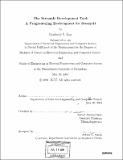| dc.contributor.advisor | Saman Amarasinghe. | en_US |
| dc.contributor.author | Kuo, Kimberly Sue, 1981- | en_US |
| dc.contributor.other | Massachusetts Institute of Technology. Dept. of Electrical Engineering and Computer Science. | en_US |
| dc.date.accessioned | 2005-09-26T20:23:23Z | |
| dc.date.available | 2005-09-26T20:23:23Z | |
| dc.date.copyright | 2004 | en_US |
| dc.date.issued | 2004 | en_US |
| dc.identifier.uri | http://hdl.handle.net/1721.1/28427 | |
| dc.description | Thesis (M. Eng. and S.B.)--Massachusetts Institute of Technology, Dept. of Electrical Engineering and Computer Science, 2004. | en_US |
| dc.description | Includes bibliographical references (leaves 127-130). | en_US |
| dc.description.abstract | StreamIt [28] is a high-level programming language intended for the development of large-scale and high-performance streaming applications that are characterized by the processing of data streams by modular structures. The StreamIt Development Tool (SDT) [25] is designed to aid the coding and simultaneous code- and graph-based debugging and visualizing of programs written in StreamIt. The goal is to provide a graphical programming environment that simply and intuitively conveys the hierarchical and structured nature of the StreamIt language by visually interpreting the dynamic behavior and graph representation of a StreamIt application. Consequently, the SDT provides utilities for program creation and code editing, compilation and launch support, breakpoints and code stepping, general debugging infrastructure, help support, stream graph examination and navigation, and stream data display, modification, and tracking. A user study evaluating the SDT uncovered several problems and areas of improvement that need to be addressed before this tool can approach its goals. Assessment of the SDT's efficacy in its current state is inconclusive--the SDT demonstrates both the ability to improve and hinder a user's debugging ability. Facilitating effective coding and debugging techniques and developing for scalability are critical elements in improving the SDT's effectiveness. | en_US |
| dc.description.statementofresponsibility | by Kimberly S. Kuo. | en_US |
| dc.format.extent | 130 leaves | en_US |
| dc.format.extent | 7083480 bytes | |
| dc.format.extent | 7099575 bytes | |
| dc.format.mimetype | application/pdf | |
| dc.format.mimetype | application/pdf | |
| dc.language.iso | en_US | |
| dc.publisher | Massachusetts Institute of Technology | en_US |
| dc.rights | M.I.T. theses are protected by copyright. They may be viewed from this source for any purpose, but reproduction or distribution in any format is prohibited without written permission. See provided URL for inquiries about permission. | en_US |
| dc.rights.uri | http://dspace.mit.edu/handle/1721.1/7582 | |
| dc.subject | Electrical Engineering and Computer Science. | en_US |
| dc.title | The StreamIt development tool : a programming environment for StreamIt | en_US |
| dc.title.alternative | SDT : a programming environment for StreamIt | en_US |
| dc.type | Thesis | en_US |
| dc.description.degree | M.Eng.and S.B. | en_US |
| dc.contributor.department | Massachusetts Institute of Technology. Department of Electrical Engineering and Computer Science | |
| dc.identifier.oclc | 56993753 | en_US |
